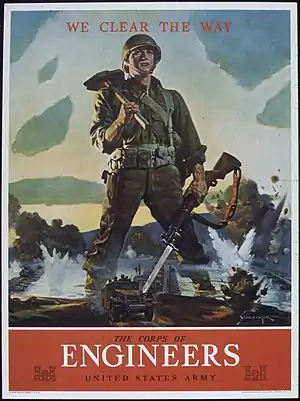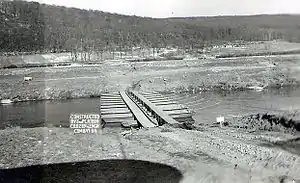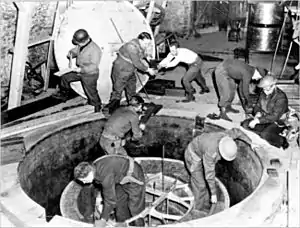Engineer Combat Battalion
An Engineer Combat Battalion (ECB) was a designation for a battalion-strength combat engineering unit in the U.S. Army, most prevalent during World War II. They are a component of the United States Army Corps of Engineers.

Also known as "Combat Engineer Battalions", they were typically divided into four companies: A, B, C, and Headquarters and Service (H&S).[1]
Best known for pontoon bridge construction and clearing hazards in amphibious landings, their duties also included serving as sappers deploying and deactivating explosive charges and unexploded munitions, mapmaking, camouflage, and a wide variety of construction services supporting frontline troops. They also fielded defensive .30 cal. and .50 cal. machine gun squads, anti-tank rocket and grenade launchers, and were required to fight as infantry when needed.[2]
Combat engineers played important roles in numerous World War II battles, especially breaching the heavily fortified Siegfried Line protecting the German border and numerous defensive lines established by the Wehrmacht in Italy, including the Gustav Line. Among the most familiar for their heroism and contributions to establishing key bridgeheads in the European Theater was at the Ludendorff Bridge at the Battle of Remagen.
Combat engineers also played roles in several unconventional operations, including the securing of elements of the German nuclear weapons program in Operation Big[3] and recovery of stolen art and treasure subsequently returned to its original owners by the Monuments Men.[3]
In the Pacific Theater the U S Army 42nd Combat Engineers took part in the hard-fought high casualty Battle of Attu Aleutian Islands (1943) and the Battle of Manila, Luzon Philippines (1945), earning 2 Battle Stars.
In the early morning of 29 May 1943, the 50th Combat Engineers were the first U S Army unit encountered by the last Japanese troops on the island, making a suicide charge toward artillery atop Engineer Hill. 50th Engineers fought back immediately and kept fighting while nearby combat units arrived.[4][5]
Capabilities


A World War II era combat engineer battalion possessed both combat and combat support capabilities. These included, but were not limited to:[2][6]
- Bridge (mobile, floating, fixed), rail, & road construction and maintenance
- Conducting river crossings by pontoon/raft, motor-powered assault boats
- Demolition
- Placing/de-arming munitions, including mines
- Port & harbor maintenance and rehabilitation, including beachheads:
- Laying roads and unloading/loading supplies, vehicles & personnel from transport and cargo ships
- Camouflage
- Water supply and sanitation
- Map production
- Vehicle maintenance
- Establishing/maintaining supply and ammunition dumps
- Building barracks, depots, and similar structures
- Rescue & road patrols, bridge and road reconnaissance
- Clearing of debris and wreckage
- Unit defense and intelligence
- Fighting as infantry when needed
US units


Combat Engineer Battalions in the U.S. military include:
- 1st Engineer Combat Battalion
- 2nd Engineer Combat Battalion
- 9th Engineer Combat Battaltion
- 14th Engineer Combat Battalion
- 15th Engineer Battalion
- 16th Engineer Battalion
- 19th Combat Engineer Battalion
- 20th Engineer Battalion
- 31st Engineer Combat Battalion
- 41st Engineer Battalion
- 42nd Engineer Combat Battalion
- 50th Engineer Combat Battalion[7]
- 65th Engineer Battalion
- 82nd Engineer Combat Battalion[8]
- 114th Engineer Combat Battalion
- 135th Engineer Combat Battalion
- 206th Engineer Combat Battalion
- 244th Combat Engineers
- 248th Engineer Combat Battalion
- 249th Engineer Combat Battalion
- 254th Engineer Combat Battalion
- 257th Engineer Combat Battalion (WW2)
- 258th Engineer Combat Battalion
- 283rd Engineer Combat Battalion
- 289th Engineer Combat Battalion
- 291st Engineer Combat Battalion
- 296th Engineer Combat Battlion[9]
- 298th Engineer Combat Battlion
- 299th Engineer Combat Battalion[10]
- 311th Engineer Combat Battalion, 8th Blackhawk Division, European Theater
- 402nd Engineer Battalion
- 554th Engineer Battalion
- 864th Engineer Battalion
- 1269th Engineer Combat Battalion
- 1288th Engineer Combat Battalion
- 1695th Engineer Combat Battalion
References
- Summary information on Engineer Combat Battalions
- United States Government War Department Engineer Field Manual FM-5-5, Engineer Troops, 11 October 1943
- "1269th Engineer Combat Battalion - History". psu.edu.
- "History of the 50th Engineer Combat Battalion" (PDF). nps.gov.
- "The Storm on Our Shores: One Island, Two Soldiers, and the Forgotten Battle of World War II". Mark Obmascik, 2019.
- What Did Combat Engineers Do? 327th Engineer Combat Battalion list
- 50th Engineer Combat Battalion History
- 82nd Engineer Combat Battalion History
- Bridge to Berlin
- https://history.army.mil/html/reference/Normandy/TS/COE/COE15.htm